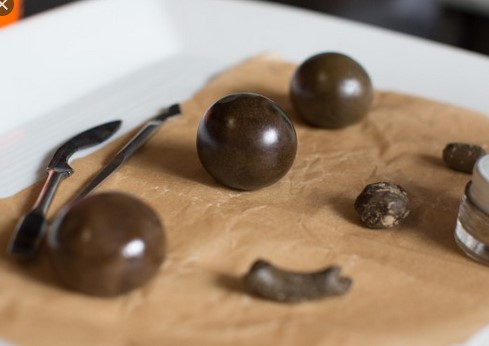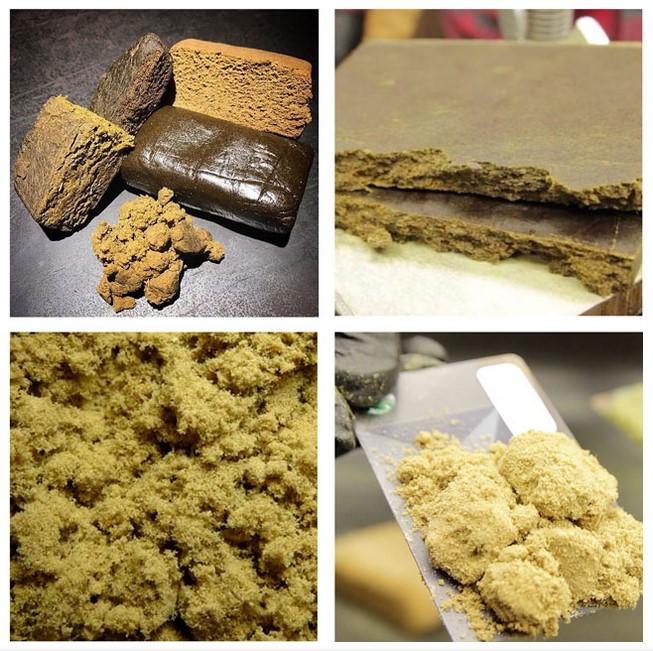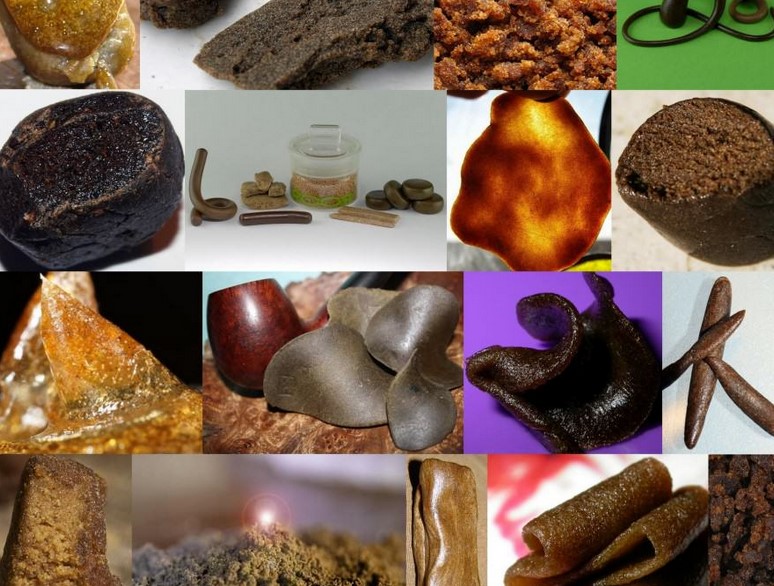Hashish or just hash, is a potent cannabis concentrate made by extracting the resin from cannabis plants and working and pressing it into solid form. It can take the form of spheres (like Nepalese temple ball hash), bricks or “cakes” like the hash made in North Africa and the Levant, and dark, sticky fingers or balls like the charas popular throughout the Indian subcontinent.

Which hash is the finest depends on who you ask. There are those who prefer the dark, sticky charas of the Himalayas or the potent hash of many an Afghan mountain valley, while countless people – especially in Europe – swear by sweet, often blond Moroccan hashish. Whichever hash you have, it should have a fragrant, rather spicy aroma, an earthy flavor, and a high that makes you want to curl up with a hot cup of chai at a Hindu Kush hill station and ask “what is snow if not the tears of G-d, frozen as they cascade to Earth?”
The building blocks of hashish can be found on the flowers and leaves of cannabis. Glandular trichomes, the sparkly crystals that cover potent cannabis flower (and the “sugar leaves” that sprout from buds), are a form of resin that contains the cannabinoids and terpenes produced by the plant. This resin is responsible for the high of cannabis, as well as the flavors and aromas that set different cannabis chemovars apart from the crowd.
Once removed from the plant, this resin can be collected and processed into hash using a variety of methods — including ones that have been with us since antiquity.
The different types of hash
Old school hash

From the Himalayan foothills to the back alleys of Cairo and the Rif mountains of Morocco, hash has been an international phenomenon for centuries.
When we look at (really) old school hash, they tend to take a few forms. In North Africa and the Levant, cannabis plants are harvested and dried, after which the buds are worked by hand until the dry trichomes – what is often called kief – separates from the flowers. The kief is then collected and pressed into bricks or “cakes” of hash.
Perhaps the oldest form of hash is Charas – very similar to Nepalese Temple Balls – which is traditionally made by taking fresh (not dried) cannabis buds and rolling them between your hands gradually for hours to let the resin accumulate on your palms, where it is later collected and pressed into “fingers” or balls.
Dry sift hash
Dry sift hash is basically the method used in North Africa and the Levant, and involves taking dried buds and removing the trichomes so they can be collected and processed. Dry sift hash is usually made using a fine or micron screen, and working the buds over the surface like a gold prospector, if a bit more productive.
Bubble hash
The name “bubble hash” comes from the method used to make this type of hash, which is also referred to as “water hash.” The process involves using ice, water, and filter bags to remove trichomes from cannabis flower and trim, which can then be easily dried and pressed into hash.
Rosin
Rosin is a very popular cannabis concentrate which is made by using heat and pressure to extract resin from the plant matter, in the form of a syrupy sap. This form of hash oil can be as potent as lab-produced, solvent-based cannabis extracts, and can be dabbed with ease – and to potent effect.

How to make hash
Making hash on your own, with even the most rudimentary of tools is easy and straightforward. Here are three very simple methods for making your own batch.
How to make dry sift hash
To make hash with kief, simply work the dry buds or trim back and forth gently over micron screens, letting all of the kief fall to a tray below. Typically the smaller the gauge, the finer the kief you’ll harvest. The dry sift method is very versatile because once the kief has collected below, you can either press it into hash, or just put it aside and have a stash of kief that you can sprinkle on bowls or into joints whenever the urge strikes.
Instructions:
- Get a set of micron screens with a micron count of 60-200, or a single pollen box.
- If using the screens, stack them with the highest micron count screen at the top and start rubbing the cannabis back and forth on the top screen, working the trichomes off so they fall below. You want to make sure not to push so hard that you force any of the flowers or trim through the screen. Take the layer of kief that has fallen below to the next screen and use a plastic card to work it across the next screen until it falls below, repeating this step until you get to the bottom layer.
- Take the kief and put it between two baking sheets or pieces of parchment paper and apply heat, pressing it hard to form it into a block. There are various methods of applying heat, including using a hair straightener or a tightly-sealed glass jar filled with boiling water, to name just two. You can also just put the kief in a pollen press, and compress it into a round chunk of hash.
- If using a pollen box, which is typically a large wooden or plastic box that has a micron screen inside, simply put the weed and trim inside, close the box and shake it, allowing the kief to fall through and collect on the bottom. Repeat this step until you’ve got enough kief.
How to make bubble hash
What is bubble hash you ask? Also known as water hash, bubble hash uses ice, water, and filter bags to pull the trichomes from the cannabis so it can be formed into hash.
To make bubble hash you’ll need cannabis flower and/or trim, filter bags, two buckets, cold water, and parchment paper. A lot of recipes call for using your washing machine in concert with the filter bags, ice, and water, but we’re going to focus on how to make it by hand.
Instructions:
- Take a 220 micron filter bag (aka “bubble bag”) and place it inside of a bucket.
- Place a layer of ice at the bottom of the bucket, then the cannabis you’re using, followed by another layer of ice, or alternate layers of cannabis and ice, with a layer of ice on top, and enough water so that the ice at top is just barely covered and floating.
- Let the bucket mix sit for about 15-20 minutes and then take a large wooden spoon and start stirring it in a gentle, circular motion, changing directions repeatedly. Let the mixture sit another 10 minutes or so.
- Line a second bucket with a set of filter bags ranging from 25 to 160 microns, with the 25 micron bag at the bottom.
- Take the bag with the water and cannabis mixture, close it, and let the liquid filter out of the bag into the bucket. Take that water and pour it into the second bucket with the multiple filter bags, allowing it to drain for about 10 minutes.
- Pull up the first bag – 160 microns – and use a spoon to scrape off the wet hash and set it on a press screen or a piece of cardboard to dry. Repeat this for each bag until you get to the bottom of the bucket.
After the hash is dry, you can press it into blocks. The different levels of hash will be of different grades, and you can either separate them or press them together.
You can also reuse the plant material from the first round and repeat the process from the beginning to produce more bubble hash.
Make your own hash rosin
Rosin is a very popular and potent cannabis concentrate and all it requires is some cannabis flower, kief and/or cannabis trim, parchment paper, and a hair straightener.
Instructions:
- Take your cannabis flower or dried kief and place it between two sheets of parchment paper (baking sheets work fine too).
- If using flower make sure it is well broken up and formed into a small square or triangle.
- Once your cannabis is between the two pieces of paper, use a hair straightener set to about 300℉ to press and heat it.
- If you’re using cannabis trim, place it inside a trim back before putting it between the two sheets of paper.
Use your hands to make hash. HAND-ROLLING HASH
Used to make charas, this method is done by just using the tools that you always have on hand, literally.
All you need is some freshly picked cannabis flower and your own two hands. Make sure to use flowers that aren’t fully mature and which aren’t dry.
Instructions:
- Make sure your hands are nice and clean
- Take a good sized bud on a stem and roll it gently back and forth between your hands, making sure not to use too much force or go too fast.
- Eventually, the tar-like charas will start building up on your palms.
- Take your time, and once you’ve collected a good amount of charas, scrape it off your hands and form into a ball.
Make sure to have some good, strong soap on hand, you’re going to need it to clean up afterwards.
Use cannabis trim to make hash
Cannabis trim refers to the sugar leaves and fan leaves that have trichomes on their surface and are often discarded during the trimming process. This is something of a shame, because they can actually be used to harvest kief for hash.
Making hash with weed trim is pretty easy, and quite similar to how you would make dry sift hash or rosin.
Instructions:
- Take the sugar and fan leaves and place them in a bag in your freezer for at least 24 hours, which will make the trichomes easier to remove.
- Take a fine sifting screen and run the trim back and forth over the screen just as you would with cannabis flower to make dry sift hash.
You can also fill a bubble bag with trim just like you would with cannabis flower and make bubble hash, though it will require a significant amount of trim.
In addition, you can take your trim and make rosin the same way you would with cannabis flower, just make sure to place it into a rosin bag first in order to filter it.

I make some incredibly delicious and potent hash , Jelly Hash with kief mixed with whole plant extract, its crazy potent, tastes amazing. I recently dry sifted about a kilo of trim and shake a friend gave me ( mystery strain) I sifted all it through a trim bin, got over 90 gm kief, this kief turned out to be top shelf, it started to melt and form into a chunk of hash in room temperature with gravity alone.